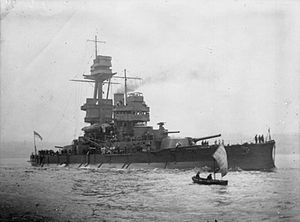HMS Glatton (1914)

Glatton during World War I
|
|
| History | |
|---|---|
|
|
|
| Name: | HMS Glatton |
| Builder: | Armstrong Whitworth |
| Laid down: | 26 May 1913 |
| Launched: | 8 August 1914 |
| Commissioned: | 31 August 1918 |
| Fate: | Wrecked by explosion, 16 September 1918 |
| General characteristics | |
| Class and type: | Gorgon-class monitor |
| Displacement: | 5,746 long tons (5,838.2 t) at deep load |
| Length: | 310 ft (94.5 m) |
| Beam: |
|
| Draught: | 16 ft 4 in (5.0 m) |
| Installed power: | 4,000 ihp (3,000 kW) |
| Propulsion: |
|
| Speed: | 12 knots (22 km/h; 14 mph) |
| Range: | 2,700 nmi (5,000 km; 3,100 mi) at 11 knots (20 km/h; 13 mph) |
| Complement: | 305 |
| Armament: |
|
| Armour: |
|
HMS Glatton and her sister ship Gorgon were originally built as coastal defence ships for the Royal Norwegian Navy, as Bjørgvin and Nidaros respectively. She was requisitioned from Norway at the beginning of World War I, but was not completed until 1918 although she had been launched over three years earlier. On 16 September 1918, before she had even gone into action, she suffered a large fire in one of her 6-inch magazines, and had to be scuttled to prevent an explosion of her main magazines that would have devastated Dover. Her wreck was partially salvaged in 1926, and moved into a position in the northeastern end of the harbour where it would not obstruct traffic. It was subsequently buried by landfill underneath the current car ferry terminal.
Bjørgvin was ordered by Norway in 1913 to supplement the older Eidsvold and Tordenskjold classes of coastal defense ships. She would have been known in Norway as P/S Bjørgvin; P/S stands for Panserskip ("armoured ship"), while Bjørgvin was the old name for the Norwegian city of Bergen. However, when World War I broke out, the Royal Navy requisitioned most warships under construction in Britain for foreign powers and refunded the two-thirds of Bjørgvin's £370,000 purchase price already paid by the Norwegians.
Bjørgvin was laid down by Armstrong Whitworth at Elswick on 26 May 1913 and launched on 8 August 1914. She was renamed Glatton after an earlier breastwork monitor of 1871. Her completion was greatly delayed by the modifications made by the British, which included modifying the boilers to use both oil and coal and conversion of 12 double-bottom tanks to carry the oil. This work began on 9 January 1915, but was suspended the following May, when it was estimated that only another 10–12 months of work remained, to allow for faster progress to be made on the large light cruisers Furious and Courageous that were building in Armstrong's Naval Yard downriver. In September 1917, work was resumed to a new design that added a large anti-torpedo bulge along about 75% of the hull's length, suppression of the torpedo tubes and 100-millimetre (3.9 in) guns planned by the Norwegians, and a large tripod mast was to be fitted behind the single funnel to carry the directors for both the 6-inch (152 mm) and 9.2-inch (234 mm) guns. Both of these guns had to be relined to use standard British ammunition and the mount for the 9.2-inch gun was modified to give a maximum elevation of 40° which gave the gun a maximum range of 39,000 yards (36,000 m). Addition of the bulges cost 2 knots (3.7 km/h; 2.3 mph) in speed, but prevented the extra weight resulting from all of these changes from deepening her draft. She was finally completed on 8 September 1918.
...
Wikipedia
